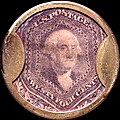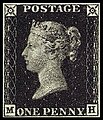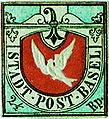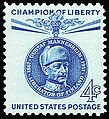Portal:Philately
| Philately portal | WikiProject Philately |
The Philately Portal
Philately is the study of revenue or postage stamps. This includes the design, production, and uses of stamps after they are issued. A postage stamp is evidence of pre-paying a fee for postal services. Postal history is the study of postal systems of the past. It includes the study of rates charged, routes followed, and special handling of letters.
Stamp collecting is the collecting of postage stamps and related objects, such as covers (envelopes, postcards or parcels with stamps affixed). It is one of the world's most popular hobbies, with estimates of the number of collectors ranging up to 20 million in the United States alone.

The postage stamps of Ireland are issued by the postal operator of the independent Irish state. Ireland was part of the United Kingdom of Great Britain and Ireland when the world's first postage stamps were issued in 1840. These stamps, and all subsequent British issues, were used throughout Ireland until the new Irish Government assumed power in 1922. Beginning on 17 February 1922, existing British stamps were overprinted with Irish text to provide some definitives until separate Irish issues became available within the new Irish Free State. Following the overprints, a regular series of definitive stamps was produced by the new Department of Posts and Telegraphs, using domestic designs. These definitives were issued on 6 December 1922, the day that the Irish Free State officially came into existence; the first was a 2d stamp, depicting a map of Ireland (including Northern Ireland, which remained a part of the United Kingdom). Since then new images, and additional values as needed, have produced nine definitive series of different designs.
These were the major stamp productions for everyday use. Commemorative stamps first appeared in 1929, and these now appear several times a year, celebrating many aspects of Irish life, such as notable events and anniversaries, Irish life and culture, and many famous Irish people. Some definitive and commemorative stamps have been produced in miniature sheet, booklet and coil configurations in addition to the common sheet layout. Postage dues and airmails complete the stamp issues of the two, sequential, Irish stamp-issuing authorities. Two styles of watermark were used though the overprinted issues came with the watermarks of the British stamps provided for overprinting by the British Post Office. (Full article...)
Selected article -
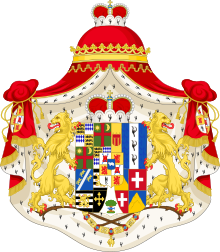
The Princely House of Thurn and Taxis (German: Fürstenhaus Thurn und Taxis, [ˈtuːɐ̯n ʔʊnt ˈtaksɪs]) is a family of German nobility that is part of the Briefadel. It was a key player in the postal services in Europe during the 16th century, until the end of the Holy Roman Empire in 1806, and became well known as the owner of breweries and commissioner of several castles. The family has resided in Regensburg since 1748 with their seat at St. Emmeram Castle from 1803. The family is one of the wealthiest in Germany, and the current head of the House is Albert, 12th Prince of Thurn and Taxis.
They are one of the mediatised Houses for their former Sovereign Imperial counties, later mediatised to Kingdom of Württemberg (Buchau Princely Abbey, now Bad Buchau), Kingdom of Bavaria and Hohenzollern-Sigmaringen. (Full article...)
Selected images
Did you know (auto-generated)

- ... that Argentinian Ricardo D. Eliçabe qualified as a physician, co-founded a petroleum refinery, and wrote about forgeries of Bolivia's first stamps?
- ... that James Diossa rescued the only public library and post office in Central Falls, Rhode Island, when the city went into bankruptcy?
- ... that a new Christmas stamp that debuted in the 350-person town of Bethlehem, Georgia, in 1967 got so much attention that the two-employee post office had to hire forty-three temporary workers?
- ... that an investigation into the Royal Oak post office shootings led one congressman to accuse the Postal Service of having been "asleep at the switch"?
- ... that after Irish post office clerk Maureen Flavin Sweeney reported worsening weather conditions, Dwight D. Eisenhower agreed to postpone D-Day by 24 hours?
- ... that both of Karl R. Free<nowiki>'</nowiki>s New Deal-era U.S. post office murals with Native American subjects have been challenged as offensive?
General images -
Selected stamp -

The Baden 9 Kreuzer Error (German: Baden-Fehldruck 9 Kreuzer) is a postage stamp error produced by the historical German state of Baden in 1851.
Baden's first postage stamps were issued on 1 May 1851. The "9 Kreuzer Green" stamp was a color misprint of the 9 Kreuzer denomination that was printed in green instead of pink. The green color was intended for the 6 Kreuzer value, but apparently, the paper sheets were mismatched. Only three cancelled copies and one unused copy of this error are known, but more sheets of paper may have been printed. The cancellations recorded have the numbers "4" for Achern, "41" for Ettenheim, and "106" for Orschweier (today Mahlberg). Two of the known copies are on letters. (Full article...)
List articles

- List of philatelists
- List of most expensive philatelic items
- List of postage stamps
- Lists of people on postage stamps (article) • (Category page)
- List of entities that have issued postage stamps (A–E)
- List of entities that have issued postage stamps (F–L)
- List of entities that have issued postage stamps (M–Z)
- List of postal services abroad
- Timeline of postal history
Related portals
Topics
Categories
WikiProject
![]() WikiProject Philately organizes the development of articles relating to philately. For those who want to skip ahead to the smaller articles, the WikiProject also maintains a list of articles in need of improvement or that need to be started. There are also many red inked topics that need to be started on the list of philatelic topics page.
WikiProject Philately organizes the development of articles relating to philately. For those who want to skip ahead to the smaller articles, the WikiProject also maintains a list of articles in need of improvement or that need to be started. There are also many red inked topics that need to be started on the list of philatelic topics page.
Selected works
- Williams, Louis N., & Williams, Maurice (1990). Fundamentals of Philately {revised ed.). American Philatelic Society. ISBN 0-9335-8013-4.
{{cite book}}: CS1 maint: multiple names: authors list (link) - Hornung, Otto (1970). The Illustrated Encyclopedia of Stamp Collecting. Hamlyn. ISBN 0-600-01797-4.
- Stuart Rossiter & John Fowler (1991). World History Stamp Atlas (reprint ed.). pub: Black Cat. ISBN 0-7481-0309-0.
Wikimedia
The following Wikimedia Foundation sister projects provide more on this subject:
-
Commons
Free media repository -
Wikibooks
Free textbooks and manuals -
Wikidata
Free knowledge base -
Wikinews
Free-content news -
Wikiquote
Collection of quotations -
Wikisource
Free-content library -
Wikiversity
Free learning tools
Other Portals
Sources
- ^ "Philatelic Collections: General Collections". British Library. 2003-11-30. Archived from the original on 30 June 2011. Retrieved 2011-01-16.




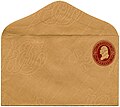


![Image 5Unissued 1956 £1 Jamaican chocolate and violet, the first stamp designed for Queen Elizabeth II. Held in the British Library Crown Agents Collection.[1]](http://upload.wikimedia.org/wikipedia/commons/thumb/9/9b/Stamp_Jamaica_1956_unissued_1sh.jpg/120px-Stamp_Jamaica_1956_unissued_1sh.jpg)

